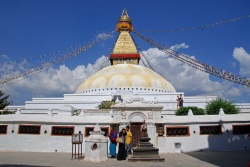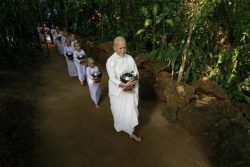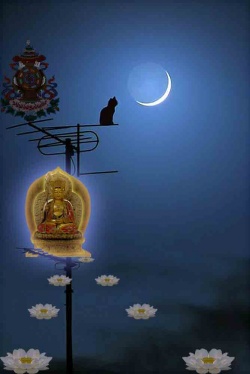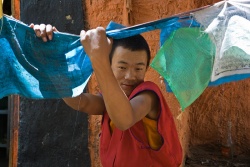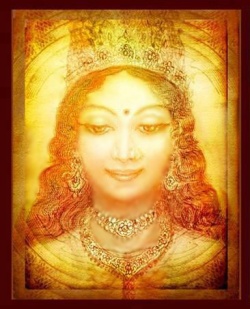The Importance of Lam Rim
Here are my notes from a short teaching Lama Gursam gave last October on Lam Rim.
Lam Rim means the stages of the Path of Tibetan Buddhism.
Everything goes stage by stage. Trying to reach the final level is like jumping into space. Many Tibetan masters have written on how to practice stage by stage.
Even though there there are many different texts, the meaning is the same. Tibetan Buddhism came from India.
The Indian master Atisha, in order to establish Buddhism in Tibet taught most compassionately. His teachings were the basis of all the schools of Buddhism in Tibet.
He was a great scholar at Nalanda. He was called "the refuge master" because he taught that extensively, despite knowing all the high and profound teachings of Buddhism.
His main text on Lam Rim is "lamp on the Path to Enlightenment."
Even though it is a short book, the commentary by learned masters on the text is extensive.
Many Tibetan wrote similar texts, such as Gampopa's Jewel Ornament of Liberation.
It was written almost 1000 years ago.
It is important to receive teachings and transmission on the Jewel Ornament.
It is mainly a Kagyu text.
The Nyingma equivalent is Words of my Perfect Teacher.
And in the Gelgpa there is the Lam Rim Chenmo.
We must study all the traditions in order to liberate our heart.
I was asked to teach by a Gelugpa center in Mexico on the songs of Milarepa.
They had not heard of other lam rim texts than the Lam Rim Chenmo.
We should study all the traditions, including the ngondro of other traditions.
We all need wisdom.
So how can we get it? We start with academic study.
Then we continue with analytic investigation.
There is a saying in Tibet: "the wisdom of study is the antidote to ignorance."
It is lighting a candle in the darkness. It is also said that study is the best wealth.
That is because it cannot be stolen from you, and sharing it only increases it.
It is also said that study is the best friend. Nehru, the first prime minister of India, always carried a bag of books with him when he traveled.
Whatever we study we must think about what he have studied. Finally, we must put it into practice with meditation.
Even though we say meditation is so important, that doesn't mean only meditation is important, we need a balance of study and practice.
Within academics we start with short texts like The 37 Bodhisattva Practices, then study the short Lam Rim texts, then Shantideva, then Abhidharma, then Madhyamika, and then the Prajnaparamita texts. Monastics study the Vinaya. And in the Kagyupa they study the texts of Maitreya.
The Jewel Ornament is divided into five sections:
The first section is the cause of enlightenment, buddha nature.
Then it talks about the conditions necessary for enlightenment.
The most important condition is the teacher.
The teacher can be many people, including parents. To be a good teacher one must have knowledge.
Then what is the fruition? it is enlightenment, free of afflictive emotions and all pain.
It also means to realize the nature of compassion and love, not just to one being, but to all beings.
The path starts with refuge practice.
Sometimes people cannot practice ngondro, and they do sadhana. My mother did ngondro many times. Then follows vajrasattva, and so on.
Sometimes Westerners can't do the ngondro and do calm abiding meditation, and I think that is wonderful. Trungpa Rinpoche especially emphasizes calm abiding meditation.
Many of his students don't hear about other practices for five or six years. Some of his older practitioners are very strong.
I love to go to a center in New Hampshire. Every day we do one or two hours of sitting, followed by a talk. They ask many questions about meditation.
We need to take care of both our body and mind. Meditation is especially important for when we die. At that time only what is in our minds and hearts can help.
There are many different types of calm abiding meditation, with object and without object. Many are described in the mahamudra texts.
There are also many stages in the Vajrayana. You complete the yidam practices, such as Tara or Chenrezig, before starting the Highest Yoga practices.
So it is good to study the Jewel Ornament of Liberation and Atisha's Path of Enlightenment.
The Dalai Lama has taught extensively on the Lam Rim Chenmo. After studying, you need to bring them all into one. For me that is the mahamudra.
And we need to practice kindness and love.
This a very hard practice, Your practice is not tested in the mountains, it is tested by other human beings. My teacher said, if you want to be in a relationship, you had better be good.
Another teacher told me, now is your time to study, so study hard. When you leave school, it will be too late.
Source
http://carelesshand.nfshost.com/archive/2012/01january/importance-of-lam-rim.html
